Advice from a Caterpillar
Studies in Alice V, by Marc Edmund Jones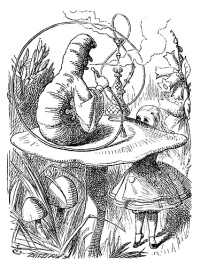
This lesson considers the fifth chapter of
Alice in Wonderland and the fifth great
principle of wisdom in the Philosophy of
Concepts as revealed through the adventures
of Alice is that divinity lies in difference.
This lesson therefore is the logical
development of the points in the preceding
lesson, for while the whole static basis of the
universe is seen to lie in the actual
changelessness of its eternal components so
the whole dynamic basis of the All is now to
be identified in the essential difference
between every one of the eternal components
and eery other. This individual difference
inherent in every existing thing is familiarly
known in such common phenomena as snow
flakes and finger prints, no two of which have
ever been found alike. Even such wholly
mechanical instruments as typewriters and
firearms are individual enough for a machine
on which a letter has been written or a rifled weapon that has fired a bullet to be identified
positively in a court of law. Differentiation is the basis of selfhood because when self is reduced
to its very last component essence it is still found to possess the individuality that differentiates it
from everything else in the universe. Indeed, this basic difference is its reality in fact and this
difference inherent in every self is the tie to divinity. "For my thoughts are not your thoughts,
neither are your ways my ways, saith the Lord." (Isaiah 55:8) The very thing which
distinguishes or identifies God in an essential difference from everything which is not wholly
divine is that which equally serves to distinguish or identify the God in man or his divinity, or his
difference. Great leaders in life have gained their respective places in the hearts of men because
of their essential difference from the led. To attempt to find the one thing held in common that
distinguishes leadership is a fruitless search unless generalities are acceptable. While
psychoanalysis will state that leadership is that state of being or consciousness that will make
possible a focusing of an individual in the libido of the many, or that men will accept a leader
because they can see and feel themselves in him, this does not indicate that leaders are like their
followers but rather that they are different enough to appeal to that essential and indefinite
difference inherent in all men.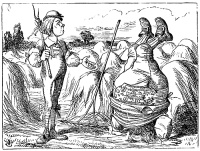
Here is the principle of assertion. Self-assertion or recognition of differentiation in self is the fundamental basis of illumination or initiation, and in this is seen the value of dissatisfaction as well as the truth of the statement that all progress in the world has been at the hands of unsatisfied people. The symbolism of this fifth chapter in Alice is interesting therefore in the characterization of the caterpillar. The real or inner self is symbolized by the worm, note Mark 8:48, and also observe the development of the primal streak or wormlike beginning of differentiation in the embryo. Here is an almost senseless contradictoriness. This contrariness of any caterpillar aids it in its gathering to self of physical substance by means of which it will become a butterfly, and the convenient symbolism of the inner self is further borne out in the fact that the true butterfly does not eat but exists through the whole span of its existence aerially or spiritually or in beauty on the vitality it has stored up in worm state. The parody here of Southey's The Old Man's Comforts, in both its essence and as a bit of verse by itself with its parody better known now by far than its original, is in its change from its dignified model a striking and clever presentment of virtue of differentiation or contrariness. The psychoanalyst has much fun with Lewis Carroll at this point because he is unable to see beyond the purely personal factor of the story.
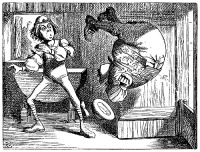 The achievement of
imagination in the chapter, or
the fifth great scientific
anticipation, is the revelation
of the principles of
endocrinology or the
functioning of the ductless
glands. These are the
mushrooms in the body or the
seemingly parasitic interstitial
matter that science now knows
controls the animal
metabolism of higher life.
There is a complementary
balance in life or growth
between the vegetable and
animal kingdoms with the
vegetable including mineral and the animal including the human in this fundamental polarity of
visible or created manifestation, and this is marked by the inbreathing of oxygen and
outbreathing of carbon dioxide on the part of higher life and the inbreathing of carbon dioxide
and the outbreathing of oxygen on the part of lower or vegetable life. In the plants the
chlorophyll of the leaves acting with the aid of sunlight in photosynthesis makes possible the
retaining of the carbon as the consciousness agency. Living matter is always a chemical
combination of carbon. In the animal organism the endocrine tissue acting with the aid of
combustion, heat and oxidation makes possible the utilization of the oxygen as the consciousness
agency to support blood vaporization. This is most simply shown in the astonishing revival of
the apparent dead by injection of adrenaline or preparation of the substance of the adrenals or
ductless glands situated on the kidneys.
The achievement of
imagination in the chapter, or
the fifth great scientific
anticipation, is the revelation
of the principles of
endocrinology or the
functioning of the ductless
glands. These are the
mushrooms in the body or the
seemingly parasitic interstitial
matter that science now knows
controls the animal
metabolism of higher life.
There is a complementary
balance in life or growth
between the vegetable and
animal kingdoms with the
vegetable including mineral and the animal including the human in this fundamental polarity of
visible or created manifestation, and this is marked by the inbreathing of oxygen and
outbreathing of carbon dioxide on the part of higher life and the inbreathing of carbon dioxide
and the outbreathing of oxygen on the part of lower or vegetable life. In the plants the
chlorophyll of the leaves acting with the aid of sunlight in photosynthesis makes possible the
retaining of the carbon as the consciousness agency. Living matter is always a chemical
combination of carbon. In the animal organism the endocrine tissue acting with the aid of
combustion, heat and oxidation makes possible the utilization of the oxygen as the consciousness
agency to support blood vaporization. This is most simply shown in the astonishing revival of
the apparent dead by injection of adrenaline or preparation of the substance of the adrenals or
ductless glands situated on the kidneys.
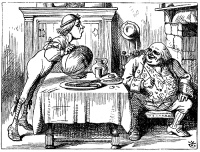 The mushrooms possess
no chlorophyll and so are
parasites in the vegetable
kingdom. They are the
link leading vegetable
matter to animal form and
therefore glands in the
animal body of animals
and human beings are the
sustaining and supporting
agency of animal form.
That a caterpillar should
be seated on a mushroom
is itself a remarkable bit
of inspirational imagining,
and that one side of this
mushroom should cause
Alice to grow and that the
other should reduce her in stature is so perfect a picture of the functioning of the anterior and
posterior lobes of the pituitary body as to make Alice in Wonderland forever immortal as an
achievement in symbolism. Growth and its lack, especially in stature as in acromegaly or
giantism except in stature and similar disorders of animal development, is controlled entirely by
these two lobes in counterbalance. The hookah or an arrangement to pass smoke through water
is an added touch of unwitting genius, for the endocrines alone make possible the entrance of
spirit or smoke into sensation or water.
The mushrooms possess
no chlorophyll and so are
parasites in the vegetable
kingdom. They are the
link leading vegetable
matter to animal form and
therefore glands in the
animal body of animals
and human beings are the
sustaining and supporting
agency of animal form.
That a caterpillar should
be seated on a mushroom
is itself a remarkable bit
of inspirational imagining,
and that one side of this
mushroom should cause
Alice to grow and that the
other should reduce her in stature is so perfect a picture of the functioning of the anterior and
posterior lobes of the pituitary body as to make Alice in Wonderland forever immortal as an
achievement in symbolism. Growth and its lack, especially in stature as in acromegaly or
giantism except in stature and similar disorders of animal development, is controlled entirely by
these two lobes in counterbalance. The hookah or an arrangement to pass smoke through water
is an added touch of unwitting genius, for the endocrines alone make possible the entrance of
spirit or smoke into sensation or water.
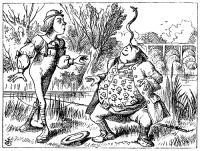 The law of applied
psychology or the fifth big
idea for the solution of
personal problems is
brought out here in the
technique of wisdom. The
serpent that eternally
symbolizes wisdom is well
defined by the pigeon or the
dove, the symbol of the
spirit that is Jonah, or by
sign or symbol that only
Jesus would give. All who
eat eggs get understanding
from the germ or essence of
the egg or seed of things.
In this incident the
phenomenon of the use of
knowledge is made clear and is symbolized by the right and left hands. The right is the
conscious activity of being leading to specialization or growing small whereas the left is the
subconscious leading to universalization or growing large. As good measure in this rich
symbolism the student of numerology will find much of interest in Alice's various dimensions.
The student must learn to EAT SOMETHING and wrap himself around substance. If man will
eat of the spirit and of the earth, or subconscious and conscious matter alternately until balance in
understanding is struck, he will be able to master all problems.
The law of applied
psychology or the fifth big
idea for the solution of
personal problems is
brought out here in the
technique of wisdom. The
serpent that eternally
symbolizes wisdom is well
defined by the pigeon or the
dove, the symbol of the
spirit that is Jonah, or by
sign or symbol that only
Jesus would give. All who
eat eggs get understanding
from the germ or essence of
the egg or seed of things.
In this incident the
phenomenon of the use of
knowledge is made clear and is symbolized by the right and left hands. The right is the
conscious activity of being leading to specialization or growing small whereas the left is the
subconscious leading to universalization or growing large. As good measure in this rich
symbolism the student of numerology will find much of interest in Alice's various dimensions.
The student must learn to EAT SOMETHING and wrap himself around substance. If man will
eat of the spirit and of the earth, or subconscious and conscious matter alternately until balance in
understanding is struck, he will be able to master all problems.

Sabian.org





